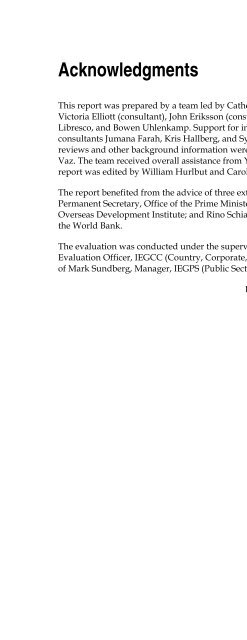An Evaluation of the World Bank's Trust Fund Portfolio
An Evaluation of the World Bank's Trust Fund Portfolio
An Evaluation of the World Bank's Trust Fund Portfolio
- No tags were found...
You also want an ePaper? Increase the reach of your titles
YUMPU automatically turns print PDFs into web optimized ePapers that Google loves.
SUMMARYdonor funds in line with recipient priorities.They have allowed donors to target priorityissues or countries, while at <strong>the</strong> same timehelping mitigate <strong>the</strong> limits <strong>of</strong> bilateral aidexpertise and enhance aid coordination. Thefunds should be managed and accounted forusing <strong>the</strong> same processes as for Bank budgetor IDA/IBRD lending, and <strong>the</strong> relevant vicepresidential unit (VPU) should be accountablefor <strong>the</strong>ir use and results in <strong>the</strong> context <strong>of</strong>country assistance strategies. If <strong>the</strong> existingtrust fund portfolio were mapped to thisproposed pillar, <strong>the</strong> pillar would account fornearly two-thirds <strong>of</strong> total IBRD/IDA trustfund disbursements.Global and Regional PartnershipPrograms: For trust-fund supported multiplecountryprograms in which donors want to beactively involved in governance andimplementation, a formally structuredpartnership can foster stakeholder voice,transparency in governance and operations,and accountability for results. When partnersselect this option, <strong>the</strong> Bank should continue toparticipate and require that each partnershipprogram have a charter, a governing body, amanagement unit, and terms <strong>of</strong> reference toguide <strong>the</strong> Bank’s participation. If <strong>the</strong> existingtrust fund portfolio were mapped to thisproposed pillar, <strong>the</strong> pillar would account forabout one-quarter <strong>of</strong> total IBRD/IDA trustfund disbursements. Umbrella Facilities: The Bank and donorsshould phase out <strong>the</strong> o<strong>the</strong>r multiple-recipientcountryfunds (including both those thatsupport Bank-executed activities and thosethat support recipient-executed activities) andestablish instead a small number <strong>of</strong>multidonor, multirecipient umbrella facilities tomobilize and deploy trust fund resources. Thisapproach would help to solve <strong>the</strong> problemsidentified in <strong>the</strong> evaluation—operationalinefficiency, inadequate accountability forresults, and lack <strong>of</strong> objective and transparentallocation criteria.Each such umbrella facility would be designedto support one or more <strong>of</strong> <strong>the</strong> strategicpriorities agreed by <strong>the</strong> donors and <strong>the</strong> Bank.For example, <strong>the</strong> Bank might establish onefacility focused on a priority <strong>the</strong>me such asgovernance or social development, whichwould receive trust fund contributions andallocate resources upfront to VPUs for work in<strong>the</strong> <strong>the</strong>matic area. The administrativearrangements for each facility would bedesigned to consolidate fundraising, allocate<strong>the</strong> funds predictably and efficiently, and holdBank staff and management accountable forresults. Arrangements need not be uniformacross <strong>the</strong> facilities and could include subfacilitiesor windows to which donors coulddirect contributions. The Bank would providea single annual report on each facility to <strong>the</strong>Bank’s Board and all <strong>the</strong> facility’s donors(ra<strong>the</strong>r than reporting to donors individually).If <strong>the</strong> existing trust fund portfolio weremapped to this proposed pillar, it wouldaccount for only about one-tenth <strong>of</strong> totalIBRD/IDA trust fund disbursements.Implementing this recommendation wouldentail a careful consultation process betweendonors and <strong>the</strong> Bank, addressing, for example,selection <strong>of</strong> <strong>the</strong>mes, mobilization <strong>of</strong> resources,and phase out <strong>of</strong> existing trust fundarrangements. IEG <strong>the</strong>refore recommendsthat senior management consult with <strong>the</strong>Bank’s shareholders and trust fund donors on<strong>the</strong> broad parameters <strong>of</strong> this change, and <strong>the</strong>nstructure and launch two or more umbrellafacilities by July 2012, with <strong>the</strong> intention <strong>of</strong>making a full conversion by <strong>the</strong> end <strong>of</strong> 2016.2. FOR FIFS. In light <strong>of</strong> <strong>the</strong> distinctive nature <strong>of</strong> <strong>the</strong>Bank’s role in relation to FIFs and <strong>the</strong> FIFportfolio’s considerable size, heterogeneity, variedexperience, and risks, <strong>the</strong> Bank should streng<strong>the</strong>n itsframework for guiding its acceptance andmanagement <strong>of</strong> FIFs going forward. To do so,Bank management should:Review experience to date on <strong>the</strong>development effectiveness <strong>of</strong> <strong>the</strong> funds and<strong>the</strong>ir synergy with <strong>the</strong> Bank’s own operations,and, based on that review, revisit OperationalPolicy 14.40’s adequacy for guidingacceptance and management <strong>of</strong> FIFs as adistinct business line.Seek Board approval for each proposed newFIF.Report to <strong>the</strong> Board regularly on FIFs’delivery <strong>of</strong> intended results and <strong>the</strong>xii
















